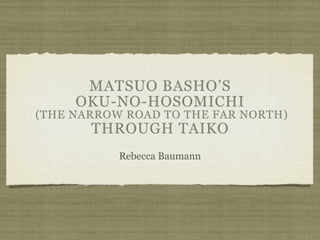
World lit. final_project
- 1. MATSUO BASHO’S OKU-NO-HOSOMICHI (THE NARROW ROAD TO THE FAR NORTH) THROUGH TAIKO Rebecca Baumann
- 2. TAIKO ~ A rhythmic style of drumming that is usually done in ensembles Historians are not positive as to where is originated, but it is known to have been in Japan for over 2000 years The taiko drum was originally used as a battlefield instrument, but soon it became a representation of the gods, nobility, and religious ceremony http://www.youtube.com/watch?v=_n-6KC2RdGQ&feature=related
- 3. MATSUO BASHO AND HAIKU Born in 1644 in Osaka, Japan He is renowned for the artistry in his Haiku poems He studied Zen, History, and poetry in Edo, Japan (now modern Tokyo) Wrote The Narrow Road to the Far North in 1689
- 4. THE NARROW ROAD TO THE FAR NORTH ~A series of travelogues mixed with haiku It talks about Basho’s dangerous journey through Japan Basho is comfortable with travel and states, “every day is a journery, and the journey itself home.”
- 5. THE TAIKO MYTH One day Ameterasu was so angered by the teasing of her brother that she locked herself in a cave, rolled a huge stone across the entrance and vowed never to come out again. The world lay in darkness as the other gods tried pleas, threats and even force to roll back the stone and open the cave, but to no avail. All knew that if the sun goddess kept her light hidden in the cave too long, the plants and animals of this world would surely die. At last Uzume, a wild and wily goddess, came along and announced that she could force Ameterasu from the cave. The others sneered, as the mightiest of the other gods had tried to move the stone and failed miserably. Uzume simply smiled as she opened a sake barrel, dispensed its contents and turned it upside down. Then she began the most boisterous and frenetic dancing upon the head that any there had ever seen or heard. All around her laughed and sang as she danced and pounded on the barrel. Ameterasu, hearing the commotion outside the cave, wondered as to what could so amuse the gods that they had forgotten the darkness. Curious, she rolled away the stone and emerged from the cave. And that is how sunlight returned to the world and how the first taiko was made.
- 6. TAIKO AND HAIKU Both Taiko and Haiku are associated with nature and spirituality Use rhythms in meter
- 7. BAHO’S WORK IN MUSIC Counting Rhythm and Meter 4/4: 1+2+3+4 5/8: 1+2+3+4+5 OR 1+2+3+1+2 7/8: 1+2+3+4+5+6+7 OR 1+2+3+4+1+2+3
- 9. COMPOSITION AND HAIKU In comparison to The Narrow Road to the Far North, the song: begins with loud traditional taiko drums, starting the journey uses 4/4 meter to represent the prose of Basho’s work then switches between 5/8 and 7/8 to produce the 5-7-5 haiku format uses traditional sounds and representations of incidents from the work: a shaker as the cicada’s call, loud cymbals show peril that Basho may encounter on the road, people laughing represent Basho’s run-in with prostitutes at a hotel, ends in tranquility-mirroring Basho’s state of mind when traveling.
Notas do Editor
- \n
- \n
- \n
- \n
- \n
- \n
- \n
- \n
- \n
- \n
- \n
